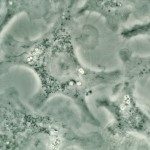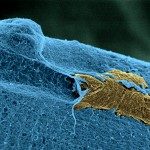Lien vers Pubmed [PMID] – 23587947
Antimicrob. Agents Chemother. 2013 Jul;57(7):3046-59
Aspergillus fumigatus causes life-threatening infections, especially in immunocompromised patients. Common drugs for therapy of aspergillosis are polyenes, azoles, and echinocandins. However, despite in vitro efficacy of these antifungals, treatment failure is frequently observed. In this study, we established bioluminescence imaging to monitor drug efficacy under in vitro and in vivo conditions. In vitro assays confirmed the effectiveness of liposomal amphotericin B, voriconazole, and anidulafungin. Liposomal amphotericin B and voriconazole were fungicidal, whereas anidulafungin allowed initial germination of conidia that stopped elongation but allowed the conidia to remain viable. In vivo studies were performed with a leukopenic murine model. Mice were challenged by intranasal instillation with a bioluminescent reporter strain (5 × 10(5) and 2.5 × 10(5) conidia), and therapy efficacies of liposomal amphotericin B, voriconazole, and anidulafungin were monitored. For monotherapy, the highest treatment efficacy was observed with liposomal amphotericin B, whereas the efficacies of voriconazole and anidulafungin were strongly dependent on the infectious dose. When therapy efficacy was studied with different drug combinations, all combinations improved the rate of treatment success compared to that with monotherapy. One hundred percent survival was obtained for treatment with a combination of liposomal amphotericin B and anidulafungin, which prevented not only pulmonary infections but also infections of the sinus. In conclusion, combination therapy increases treatment success, at least in the murine infection model. In addition, our novel approach based on real-time imaging enables in vivo monitoring of drug efficacy in different organs during therapy of invasive aspergillosis.



